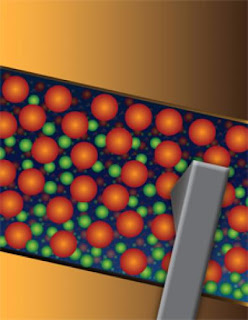The researchers set out to understand the fundamental physics of the material -- that is, what happens when it encounters an electric field, both at the interfaces and inside the film. By fabricating a device out of the ruthenium metal complex that was spin-coated onto an insulating substrate with pre-patterned gold electrodes, the scientists were able to use electron force microscopy to measure directly the electric field of the device.
A long-standing question, according to George G. Malliaras, associate professor of materials science and engineering, director of the Cornell NanoScale Science and Technology Facility and one of the co-principal investigators, was whether an electric field, when applied to the material, is concentrated at the interfaces or in the bulk of the film.
The researchers discovered that it was at the interfaces -- two gold metal electrodes sandwiching the ruthenium complex film -- which was a huge step forward in knowing how to build and engineer future devices.
"So when you apply the electric field, ions in the material move about, and that creates the electric fields at the interfaces," Malliaras explained.
Essential to the effort was the ability to pattern the ruthenium complex using photolithography, a technique not normally used with such materials and one that took the researchers more than three years to perfect, using the knowledge of experts in nanofabrication, materials and chemistry.
The patterning worked by laying down a gold electrode and a polymer called parylene. By depositing the ruthenium complex on top of the parylene layer and filling in an etched gap between the gold electrodes, the researchers were then able to peel the parylene material off mechanically, leaving a perfect device.
Ruthenium tris-bipyridine has energy levels well suited for efficient light emission of about 600 nanometers, said Héctor D. Abruña, the E.M. Chamot Professor of Chemistry, and a principal co-investigator. The material, which has interested scientists for many years, is ideal for its stability in multiple states of oxidation, which, in turn, allows it to serve as a good electron and hole transporter. This means that a single-layer device can be made, simplifying the manufacturing process.
"It's not fabulous, but it has a reasonable emission efficiency," Abruña said. "One of the drawbacks is it has certain instabilities, but we have managed to mitigate most of them."
Among the other authors were co-principal investigators Harold G. Craighead, the C.W. Lake Jr. Professor of Engineering, and John A. Marohn, associate professor of chemistry and chemical biology. ###
Contact: Press Relations Office. pressoffice@cornell.edu, 607-255-6074. Cornell University News Service
Technorati Tags: Nano or Nanotechnology and Nanotech and Cornell University or light-emitting nanodevice and ruthenium metal complex or Presidential Podcast 10/27/07 and Happy Halloween Banners and Taming tiny, unruly waves for nano optics















No comments:
Post a Comment